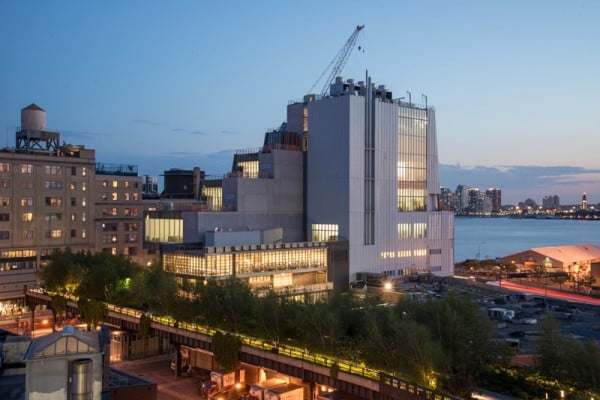
During the Whitney Museum of American Art’s annual fall gala, held last night at its now-shuttered Marcel Breuer-designed building, director Adam D. Weinberg announced that the New York institution’s long-awaited Meatpacking District home will celebrate its public opening on May 1, 2015.
Designed by Renzo Piano, the new building is located at the base of the High Line at 99 Gansevoort Street between Washington and West Streets. The architect has had a busy year in museums, overseeing the redesign of the Harvard Art Museums in Cambridge, Massachusetts, and constructing the $106 million Centro Botín in Santander, Spain (see “Critics Trash Renzo Piano’s Harvard Museums Expansion” and “$106 Million Art Center Rises in Spain“).
Details surrounding the Whitney project had been slow to leak (see “Secrecy Surrounds Whitney Reopening Announcements“), until an initial hardhat tour was offered on this past May 1, ultimately one year to the day before the planned opening (see “New Whitney Building, Like Noah’s Ark, Could Ferry All of American Art to Safety“).
In its new home, the Whitney will enjoy roughly double the exhibition space, allowing the museum to present temporary exhibitions alongside and within the context of its 20th- and 21st-century American art collection. This dramatic increase in scale, plus the expected rise attendance from High Line foot traffic, sees the Whitney poised to compete with the Museum of Modern Art for supremacy in the realm of the modern art museum (see “New Whitney Ready to Take on MoMA“).
Expanded Facilities
The expanded facilities will also include an education center with class rooms, replacing its LOT-EK-designed freestanding educational studio (see “Whitney Museum Gives Its Pop-Up Studio to Socrates Sculpture Park“); a theater; a library reading room; a black box gallery that will exhibit films, videos, and performance art; a conservation lab; and a study center for works on paper.
“We are creating an environment in which visitors will be encouraged to connect deeply with art through an irreplaceable first-hand experience,” said Weinberg in a statement. “This building will be a place of focused engagement, a site for discovery and risk-taking. Here the most important, challenging, and courageous artists of our time will have a constant presence. I am thrilled to announce that we are now so close to realizing this long-held dream for the Whitney.”
If you’re looking for an early peek at the facility, the museum has already announced plans for special viewing opportunities in late April for Whitney members, the ranks of whom, of course, swelled this year, as museum-goers looking to skip the Jeff Koons retrospective‘s long lines ponied up for an annual membership. The museum was even forced to hire a temporary “Development Records Assistant” to help process the additional paperwork generated by the membership spike (see “Koons-Spurred Membership Spike Has Whitney Seeking Extra Help“).
Construction workers who helped bring the project to completion will also receive preferential treatment in the form of a year’s worth of free admission (see “Whitney Gives Construction Workers Free Admission for a Year“).
After an inaugural show highlighting the full breadth of the museum’s permanent collection, the Whitney’s first year of exhibitions will include a major Frank Stella retrospective, a show featuring Harlem Renaissance artist Archibald Motley that originated at Duke University’s Nasher Museum), a surveillance-themed installation by Laura Poitras, and a retrospective on David Wojnarowicz.